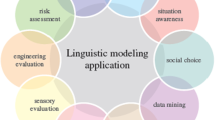Abstract
Most of modern systems for information retrieval, fusion and management have to deal with more and more qualitative information (by linguistic labels) besides information expressed quantitatively (by numbers), since human reports are better and easier expressed in natural language than with numbers. In this paper, Herrera-Martínez’s 2-Tuple linguistic representation model is extended for reasoning with uncertain and qualitative information in Dezert-Smarandache Theory (DSmT) framework, in order to overcome the limitations of current approaches, i.e., the lack of precision in the final results of linguistic information fusion according to 1-Tuple representation (q 1). The linguistic information which expresses the expert’s qualitative beliefs is expressed by means of mixed 2 Tuples (equidistant linguistic labels with a numeric biased value). Together with the 2-Tuple representation model, some basic operators are presented to carry out the fusion operation among qualitative information sources. At last, through simple example how 2-Tuple qualitative DSmT-based (q 2 DSmT) fusion rules can be used for qualitative reasoning and fusion under uncertainty, which advantage is also showed by comparing with other methods.
Similar content being viewed by others
References
F. Smarandache and J. Dezert (Editors). Advances and Applications of DSmT for Information Fusion (Collected works). American Research Press, Rehoboth, 2006, Vol.2, Ch.1 and Ch.10. http://www.gallup.unm.edu/~smarandache/DSmT-book2.pdf.
J. Dezert and F. Smarandache. A new probabilistic transformation of belief mass assignment. The 11th International Conference on Information Fusion, Cologne, Germany, June 30–July 3, 008, 1–8.
F. Herrera and L. Martínez. A 2-Tuple fuzzy linguistic representation model for computing with words. IEEE Transactions on Fuzzy Systems, 8(2000)6, 746–752.
X. Li, X. Huang, J. Dezert, and F. Smarandache. Enrichment of qualitative beliefs for reasoning under uncertainty. The 10th International Conference on Information Fusion, Québec, QC, Canada, July 09–12, 2007, 1–8.
F. Smarandache and J. Dezert (Editors). Advances and Applications of DSmT for Information Fusion (Collected works). American Research Press, Rehoboth, 2004, Chs.1–4. http://www.gallup.unm.edu/~smarandache/DSmT-book1.pdf.
G. Shafer. A Mathematical Theory of Evidence. Princeton, NJ, Princeton University Press, 1976, 1–297.
F. Smarandache and J. Dezert. Information fusion based on new proportional conflict redistribution rules. The 8th International Conference on Information Fusion, Philadelphia, PA, USA, July 25–28, 2005, 1–8.
F. Smarandache and J. Dezert (Editors). Qualitative belief conditioning rules (QBCR). The 10th International Conference on Information Fusion, Québec, QC, Canada, July 09–12, 2007, 225–232.
Author information
Authors and Affiliations
Corresponding author
Additional information
Supported by the National Natural Science Foundation of China (60804063) and 863 Program (2006AA040202).
The corresponding author: Li Xinde, born in 1975, male, Ph.D.
About this article
Cite this article
Li, X., Dai, X. Qualitative reasoning by computing with words in Herrera-Martínez’s linguistic model. J. Electron.(China) 26, 564–570 (2009). https://doi.org/10.1007/s11767-009-0016-4
Received:
Revised:
Published:
Issue Date:
DOI: https://doi.org/10.1007/s11767-009-0016-4
Key words
- Information fusion
- Qualitative reasoning under uncertainty
- Dezert-smarandache Theory (DSmT)
- 2-Tuple linguistic label




